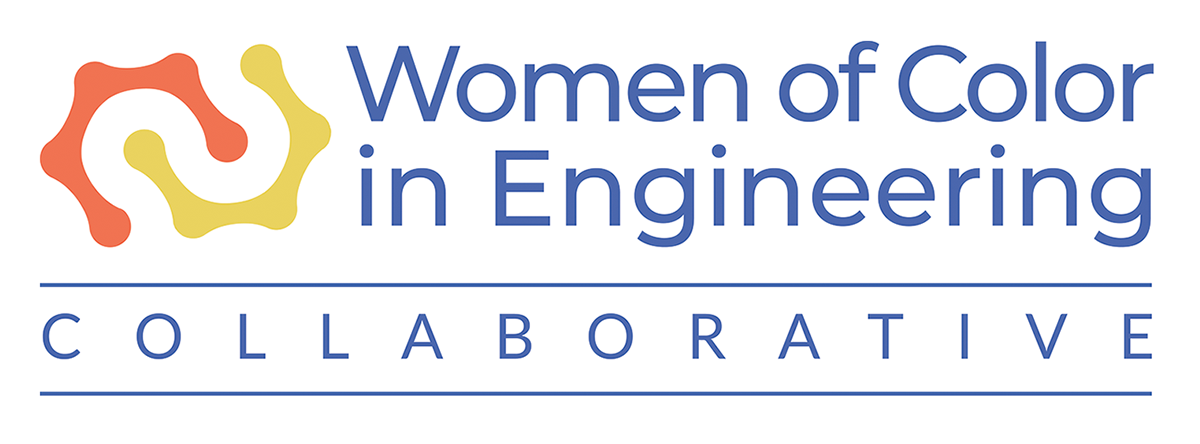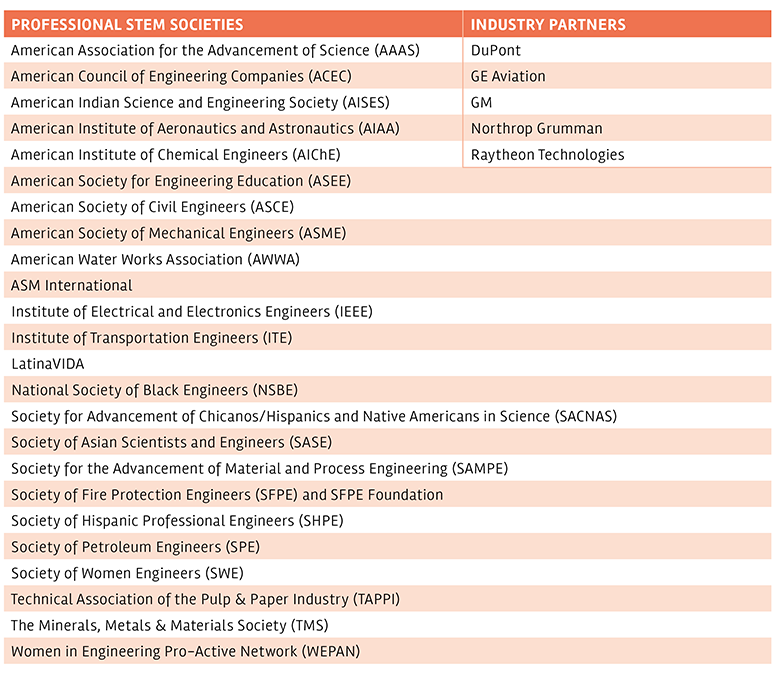
Organizations and industry partners form a collaborative to transform the culture of engineering, address crucial issues collectively, leverage resources, and make the field more inclusive and supportive of women of color.
By Roberta Rincon, Ph.D., SWE Associate Director of Research, WCEC Project Team Lead
For more than 70 years, the Society of Women Engineers has focused on increasing gender equity in engineering and technology. The long-standing underrepresentation of women and minority groups in engineering is a complex problem that requires the combined efforts of diversity-serving organizations and technical societies. While these types of organizations aim to create a welcoming and inclusive environment for its members and the engineering community, given the magnitude of the issues, greater progress will take place by working together.
The Women of Color in Engineering Collaborative (WCEC) was created for this purpose. The 20-plus WCEC member organizations acknowledge their individual organizations’ limitations in supporting women engineers of color. They believe working cooperatively will provide the resources and insight needed so that the culture of engineering becomes more inclusive and welcoming.
Creating the Women of Color in Engineering Collaborative
A recent report from the National Academies of Sciences, Engineering, and Medicine (NASEM) acknowledged that “programs intended to serve women disproportionately benefit white women, and programs intended to serve minorities mainly benefit minority males” 21 (NASEM, 2020). NASEM has recommended increasing support for women of color, specifically in recruitment, retention, and advancement (NASEM, 2022). Recognizing the impact that professional societies could have on increasing the retention of women of color in the engineering workforce, representatives from SWE, the National Society of Black Engineers (NSBE), and the Society of Hispanic Professional Engineers (SHPE) developed a National Science Foundation (NSF) proposal to create the Women of Color in Engineering Collaborative. The project team believed that many STEM professional societies whose members include women engineers of color are seeking ways to better support a diverse engineering workforce but are not always sure how best to do this. The project team believed it could address a shared issue by working to identify and leverage existing resources in a collaborative, rather than competitive, way.
In early 2021, WCEC was awarded the NSF Inclusion across the Nation of Communities of Learners of Underrepresented Discoverers in Engineering and Science (INCLUDES) Program (Award HRD-2040634) grant, which provided funds to form the WCEC and develop a shared vision and a strategic plan. The WCEC is a partnership network of professional STEM societies and companies dedicated to addressing systemic barriers that prohibit equitable work environments for women engineers of color. Table 1 lists the current WCEC partner organizations.
TABLE 1: WCEC PARTNER ORGANIZATIONS

The WCEC partner organizations met for the first time in June 2021. This virtual two-day meeting allowed the project team to introduce the WCEC concept to organizational representatives and to encourage each organization to commit to the cause. One of the first major activities undertaken by this group was to agree on a definition for women of color in engineering. The group considered what the most inclusive definition of women of color in engineering could be while also considering how their organizations define this population. Through consensus-building activities, the representatives agreed on the definition listed in Figure 1.
FIGURE 1: WCEC DEFINITION OF WOMEN OF COLOR IN ENGINEERING
Engineers and technologists who identify as a woman+ of color and whose racial and ethnic identities shape how they experience and navigate the professional landscape.
- Intersectionality is a way of recognizing and affirming all of the groups that WOC belong to and that influence their experiences within and outside of the profession.
- Lived experiences shape how WOC navigate the world through intersectional identities that require the need for the removal of barriers to achieve equitable access, advancement, and retention in technical fields.
- Primary focus includes, but is not limited to: Latina/Hispanic, Black/African American, Native American/American Indian/Alaskan Native, and Asian/Pacific Islander/Asian American/Native Hawaiian.
Before strategic planning could take place, the WCEC partner organizations also had to agree on a shared vision. A shared vision represents an ideal image of the future, so the group contemplated what the WCEC should aspire to create. The vision statement in Figure 2 provides focus for the collective efforts of the collaborative.
FIGURE 2: WCEC VISION
The vision of the Women of Color in Engineering Collaborative is for women of color to feel a sense of belonging and to be fully included in engineering; for them to thrive and to be valued as their authentic selves, empowering them to fully use their strengths to lead in positions of influence, innovate in their field, mentor, and champion others.
The WCEC partner organizations then brainstormed on the systemic barriers that could prevent the group from achieving its shared vision, particularly focusing on issues that professional STEM societies are best positioned to impact. After much discussion and deliberation, the partner organizations narrowed a large list to five systemic barriers that the WCEC could address over the next few years. Figure 3 lists the five areas of focus included in the WCEC strategic plan.
FIGURE 3: FIVE WCEC AREAS OF FOCUS
Improve Pathways to Internships, Scholarships, and Jobs in Engineering
Reduce Microaggressions, Racism, and Sexism in the Workplace
Retain and Amplify Women of Color in the Workplace
Increase Network Inclusivity and Sponsorships for Women of Color
Raise Openness and Reduce Backlash to Diversity, Equity, and Inclusion (DEI) Practices
Developing the WCEC Strategic Plan
After the first convening concluded, representatives met in small workgroups over the next few months to consider the actions the newly formed WCEC could take to address each of the five systemic barriers. Mindful of the shared vision, the workgroups discussed the intermediate and long-term outcomes they would like to see and what actions would help move the collaborative toward those outcomes. By the second convening in January 2022, the workgroups had identified a list of action items associated with each barrier for the WCEC partner organizations to consider including in the strategic plan.
Over two days, the WCEC partner organizations conversed, shared, ranked, and reached a consensus. Rankings focused on the relative importance of the action item, how innovative the strategy was, and how much impact the action could have on addressing the specific barrier. In many cases, action items could address more than one barrier, and similar action items could be consolidated. Ultimately, the two-day meeting was not enough time to finalize the work. Efforts continued into the spring during one-hour virtual meetings and multiple project team meetings.

The WCEC completed its strategic plan by summer 2022. The plan outlines the WCEC’s shared vision, mission statement, five major barriers that the WCEC will address through 2026, and associated goals and strategies for each barrier. Table 2 provides a sampling of the strategies included in the strategic plan.
TABLE 2: SAMPLE OF WCEC STRATEGIES

How to Get Involved with the WCEC
In addition to the strategic plan, the WCEC now has a website (https://www.womenofcolorengineers.org/) that explains its purpose, houses its work, and gathers contact information from those interested in becoming a WCEC member organization or connecting with the WCEC community. The website also features the WCEC Resource Center and a Women of Color profiles database. The WCEC is working to secure additional funding to support the strategic plan, build out the resource center and database, and expand the collective.
We invite you, as an individual, to join our community by visiting the WCEC website and fill out the contact form, https://www.womenofcolorengineers.org/contact-us. This will allow you to subscribe to the WCEC newsletter, speak with a WCEC representative, and stay informed about upcoming activities.
For organizations or companies interested in becoming a member of the WCEC, the website provides information on membership criteria and expectations. While the current membership includes professional STEM societies and industry partners, we aim to expand to include all types of organizations in which women engineers of color are employed, including academia and government. The WCEC partner organizations are committed to achieving systemic and cultural change and are working to increase diversity in engineering. This can best be accomplished by providing cohesive support for women of color working in the engineering profession.
Where Are the Women of Color in Engineering?
Women and people of color are underrepresented in engineering relative to their representation in the U.S. population. Women make up only 14% of engineers in the U.S. workforce, and women of color represent less than one-quarter of these. Educational institutions, nonprofits, professional societies, government, and industry all recognize the importance of diversifying the STEM workforce, noting that diverse teams are more innovative and productive than homogenous teams, and companies with more women in leadership positions are more profitable than those without (McKinsey & Company, 2020). Efforts to increase diversity in STEM fields have been made for decades, including scholarships, outreach programs, and professional development opportunities to recruit and retain diverse talent.

Many of these programs have focused on either women or people of color, overlooking the systemic barriers that women of color face in the STEM workplace. One of the biggest challenges is the number of women who leave STEM careers. The figure above shows the proportion of men and women with a bachelor’s degree in STEM who are employed in a STEM occupation. Women with STEM degrees in this age group across all races and ethnicities are more often found in non-STEM occupations than men — particularly in engineering and computer science. While access to STEM education is critical to increasing diversity in these fields, we cannot ignore the importance of retaining women in these professions, specifically women of color.
Looking at the 25- to 34-year-old age group leads to the question of why women of color are leaving the STEM workforce. A survey conducted by Kelly Services (2016) found that these women often feel stalled in their careers, perceive bias in performance evaluations, feel excluded and unwelcome, and that many senior-level women in STEM believe most women will not reach a leadership position in their companies regardless of how able or qualified they are. Women of color in engineering are often held to stricter standards of competence than white engineers (Obiomon et al., 2007). During the COVID-19 pandemic, researchers found that women engineers of color reported being passed over for important assignments compared with their white peers (SWE, 2021). These types of challenges often result in women leaving STEM altogether.
In line with the findings from the Kelly Services survey, a SWE study conducted in 2019 found that growth potential and empowering work culture were the top factors influencing women engineers to stay with their employers. Another study of women engineers (Fouad, Singh, et al., 2012) noted that women who worked in companies that valued and recognized their contributions were more satisfied with their jobs and careers. Such studies indicate that creating a more inclusive and welcoming culture that recognizes the value women of color bring to the engineering workplace can positively influence their decisions to stay.
References
McKinsey & Company (2020). Diversity Wins: How Inclusion Matters. https://www.mckinsey.com/featured-insights/diversity-and-inclusion/diversity-wins-how-inclusion-matters. May 19.
Kelly Services. (2016). Women in STEM: How and Why an Inclusive Strategy is Critical to Closing the STEM Talent Gap in Europe.
Rincon, R. and Linstroth, D. (2019). Women in Engineering: Talent Pulse Report.
Fouad, N.A., Singh, R., Fitzpatrick, M.E., and Liu, J.P. (2012). STEMming the Tide: Why Women Leave Engineering.
Society of Women Engineers. (2021). Impact of COVID-19 on Women in Engineering and Technology: A Follow-up Survey Report. Sept. 2.
National Academies of Sciences, Engineering, and Medicine. (2020). Promising Practices for Addressing the Underrepresentation of Women in Science, Engineering, and Medicine: Opening Doors. Washington, DC: The National Academies Press. https://doi.org/10.17226/25585.
National Academies of Sciences, Engineering, and Medicine. (2022). Transforming Trajectories for Women of Color in Tech. Washington, DC: The National Academies Press. https://doi.org/10.17226/26345.
Obiomon, P.H., Tickles, V.C., Wowo, A.H., and Holland-Hunt, S. (2007). Advancement of Women of Color in Science, Technology, Engineering, and Math (STEM) Disciplines. Faculty Resource Network.

